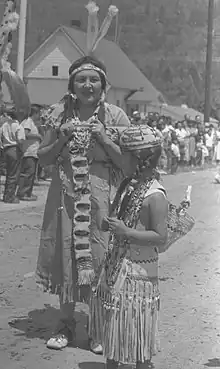Vivien Hailstone
Vivien Risling Hailstone (October 16, 1913 – July 8, 2000)[1] was a Yurok/Karok basketweaver, jewelry designer, activist and educator who led efforts to sustain traditional basket weaving patterns and techniques.[2] Hailstone also had an impact on statewide policy for repatriation of Native American remains and returning to Native American names for parks through her involvement with the State of California Department of Parks and Recreation Commission.[3]
Vivien Hailstone | |
|---|---|
 Detail of Vivien Hailstone from photograph of Buck and Vivian Hailstone at 4th of July Parade (1955) | |
| Born | Vivien Geneva Risling Humboldt County, California |
| Died | July 8, 2000 (aged 86) |
| Nationality | Yurok;Karok |
| Occupation(s) | basketweaver; jewelry designer |
Early life
Vivien Hailstone was born Vivien Geneva Risling in Humboldt County, California on October 16, 1913[4] to Geneva Orcutt (Yurok/Karok) and David Risling (Karok and a member of the Hupa tribe).[5] Her great-grandmother, Jane Young (Yurok), taught her many traditional stories, songs, and basketry techniques.[3] Her brother was David Risling, Jr.[6] a co-founder of D–Q University. Hailstone grew up in a rural area, and at age 10, she was enrolled in a Bureau of Indian Affairs boarding school in the Hoopa Valley[7] In 1940, Vivien married Albert Hailstone (Wintu) and they a child, named Albert Jr.[8]
Career and advocacy
Hailstone's efforts to sustain and promote traditional basketry are evidenced through her work in her Native community and her teaching at local colleges. She was a founding member of a pottery guild in the 1940s which incorporated Indian basketry designs into pottery designs. She served as Chair of College of the Redwood Extension Board of Directors in the 1950s and taught basketry classes at D–Q University.[8] In 1959, Hailstone opened I-Ye-Quee Trading Post & Gift Shop, which contributed to a revival of interest in Native American basketry.[9][2]
Hailstone was also an accomplished jewelry maker and designer.[10][11]
In addition to her basketmaking and jewelry, Hailstone was also an advocate for education and Native American concerns at the state level. She was a founding member of the Redding, California chapter of the California Indian Education Association.[12] In the 1970s, Hailstone became the first Native American to serve on the State of California Department of Parks and Recreation Commission.[13] She advocated for a reburial policy for remains and using Native American names for parks.[14][15]
Death and legacy
Vivien Hailstone died in 2000.[16] In 2003, the California Indian Basketweavers Association produced a video documenting Hailstone's life and basketry techniques.[17] Throughout her life Hailstone collected baskets. Her collection, along with pieces collected by her son Albert, were donated to the Clarke Historical Museum in Eureka, California.[18][19]
References
- Ortiz, Beverly R. (30 September 2000). "With Respect: Vivien Hailstone (1913-2000)". News from Native California. Berkeley. 14 (1): 13. ProQuest 217810687.
- Dennis, Yvonne Wakim; Hirschfelder, Arlene; Flynn, Shannon Rothenberger (2016-04-18). Native American Almanac: More Than 50,000 Years of the Cultures and Histories of Indigenous Peoples. Visible Ink Press. ISBN 978-1-57859-608-9.
- Ortiz, Beverly Ruth (2008). Contemporary California Indian basketry: Practice, meaning, issues (Thesis). OCLC 793947487. ProQuest 304694214.
- St. James guide to native North American artists, 1998: p. 205 (Hailstone, Vivien; b. Oct. 16, 1913, Vivien Geneva Risling; alternate name: Cutcha; tribal affiliations: Yurok/Karok; basketweaver and jewelry designer)
- Betty Lease. "Vivien Hailstone: Proud of Indian Ancestry." Redding Record Searchlight (CA), 13 Oct. 1991.
- Walters, Heidi. "Albert and the Baskets". North Coast Journal. Retrieved 2022-08-26.
- Art, women, California 1950-2000: parallels and intersections. Berkeley: University of California Press. 2002. pp. 189–190.
- Bataille, Gretchen (1993). Native American women: a biographical dictionary. Garland Publishing. pp. 100–101. ISBN 978-0-8240-5267-6.
- Grant Peters, Josephine (2010). After the First Full Moon in April: A Sourcebook of Herbal Medicine From a California Indian Elder. Routledge. ISBN 978-1-59874-364-7.
- Watchful eyes: Native American women artists. Phoenix, Arizona: Heard Museum. 1994. p. 35. ISBN 9780934351478.
- Baxter, Paula A.; Bird-Romero, Allison (2000). Encyclopedia of Native American Jewelry: A Guide to History, People, and Terms. Oryx Press. ISBN 978-1-57356-128-0.
- Chavers, Dean (2007). Modern American Indian Leaders: Their Lives and Their Work. Edwin Mellen Press. ISBN 978-0-7734-5555-9.
- Swisher, Karen Gayton; Benally, AnCita (1998). Native North American Firsts. Gale. p. 59. ISBN 978-0-7876-0518-6.
- Hirschfelder, Arlene (2012). The Extraordinary Book of Native American Lists. Lanham, MD: Scarecrow Press. p. 99. ISBN 978-0-8108-7709-2.
- Recreation, California Department of Parks and (1976). News and Views.
- "'A magnificent gift'". Times-Standard. 2014-11-01. Retrieved 2022-08-26.
- California Indian Basketweavers Association. (2003). Through the eyes of a basketweaver: Vivien Hailstone artisan.
- Medina, Vincent (2014-10-20). "The Albert and Vivien Hailstone Collection - News from Native California". Retrieved 2022-08-26.
- "Hailstone Collection". Clarke Historical Museum. Retrieved 2022-09-09.